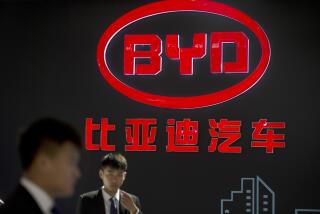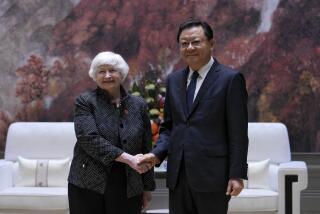China’s exports keep rising despite higher costs
HUIZHOU, China — Tony Zhang used to make cents on the dollar churning out cheap sneakers for Wal-Mart.
And like every other low-margin exporter in China’s manufacturing heartland, he was struggling to keep pace with rising costs for labor and raw materials.
Rather than run his business into the ground with ever-shrinking profits, the Taiwan-born Zhang decided to upgrade his operations. His factory just outside Shenzhen now makes specialty footwear, including fire retardant boots, steel-toed shoes and soccer cleats.
The strategy paid off. His main challenge today is finding enough workers to fill his orders. His profit margin has doubled.
“It’s different for labor-intensive businesses like us,” said Zhang, 43. “You have to have a variety of products and constantly improve to survive.”
Zhang’s business is persevering at a time when doubts are rising about China’s lasting competitiveness as the world’s factory floor.
China’s vast export sector has been battered on multiple fronts of late. The growth in demand from foreign customers is slowing. Its currency is strengthening, making Chinese goods more expensive in other countries. Hourly wages are rising. Recent headlines about poor working conditions at Foxconn Technology, the massive assembler of Apple tablets and phones, haven’t helped.
Despite it all, China has strengthened its position in the global supply chain. Already the world’s largest exporter, China’s share of global exports expanded during the recent global downturn, increasing to 10.7% last year from about 9% in 2008.
Remarkably, a major engine of growth last year was still light manufacturing, the category of low-end goods thought to be fleeing for cheaper locales in Vietnam, Cambodia or India.
China’s exports of garments, furniture, shoes and similar goods grew 23% last year and contributed $636 billion to the country’s nearly $2 trillion in total exports.
“China is offsetting the head winds because it keeps capturing more market share,” said Louis Kuijs, an economist formerly at the World Bank and now at the Fung Global Institute in Hong Kong. “Yes, labor is becoming more expensive over time, but it’s still much cheaper than the U.S. or Europe. The ratio of price to quality is still far more favorable for production in China.”
Prices for Chinese exports have risen 21% since 2005, less than the 32% increase on goods from India and 33% rise on exports from Mexico over the same period.
How much those increases in China are owed to rising wages varies depending on the industry. Workers account for about one-third of costs in labor-intensive sectors such as shoes.
But China is not content to remain just the primary source of cheap clothing and cellphones, for which manufacturers receive just a fraction of their final value.
The country’s fastest-growing category of exports is heavy machinery, such as tractors, turbines and automobiles. China’s corporate sector is determined to climb the value chain and build their brands.
China’s Sany Group, the world’s sixth-largest construction machinery builder, is buying a 90% stake in Germany’s Putzmeister Group, a leading manufacturer of concrete pumps, to boost its presence overseas.
Chinese automakers including Geely, which bought Volvo, and BYD, which counts Warren Buffett among its investors, are exporting to emerging markets to counteract sluggish sales at home. Chinese auto exports grew 49% to 814,300 units last year, according to the China Assn. of Automobile Manufacturers.
The country’s investment in heavy machinery will help China increase its share of global exports to an unprecedented 15% or more by 2020, said Janet Zhang, an analyst for GaveKal Dragonomics, a China-based economic research firm.
“China is gradually climbing up the value chain,” Zhang said. “This is an opportunity for companies to upgrade to overcome labor costs and shortages.”
China’s growing share of exports may stoke more international trade friction. The country’s ability to quickly dominate the market for solar panels, rubber tires and industrial metals resulted in U.S. import duties.
But part of that tension could be offset by China’s growing rate of imports, which has been rising faster than exports since the 2008 financial crisis because of the country’s explosive construction demand.
Beijing is trying to diversify its economy by boosting household incomes. The role of exports has been on a steady decline.
Exports accounted for 1.5 percentage points of China’s 9.2% economic expansion last year — well below the average of 4.5 percentage points during the export boom years of 2002 to 2007.
Although China’s export growth is expected to slow in the coming years, its pace will still be twice as fast as the rest of the world’s, GaveKal Dragonomics’ Zhang said.
Liam Casey, founder and chief executive of PCH International, a global supply chain management company, said China’s export sector is evolving into a leaner industry, capable of meeting increasingly sophisticated industrial demands.
“You can’t play in that low-end space. You have to add value,” Casey said, lifting one of his three iPhones to show a video of a robot at a local factory he’s partnered with stacking the outer shells of cellphones. Casey said the machinery replaced the jobs of about 100 workers.
PCH, named after California’s famous coastal highway and identified recently by Apple as one of its suppliers, links U.S. brands with a database of 1,000 factories in the southern Pearl River Delta region. The company primarily supplies cellphone and tablet accessories.
In addition to helping manufacturers build their products, Casey’s company packages the goods and fulfills online orders by sending them on air freight — tasks that would have been performed elsewhere a few years ago.
“It’s not about the China price anymore,” Casey said, referring to the term used to describe squeezing out the lowest possible margins. “It’s about the ecosystem. The supply base is built here. You think you can just transfer it? It’s not that easy.”
Tony Zhang, the shoemaker, said he’s reluctant to move inland where costs are cheaper. One of the reasons: It would be harder to locate raw materials.
He acknowledges that cheap manufacturing is phasing out. Zhang has friends who have abandoned manufacturing to open what they considered less risky ventures, such as restaurants and a campground. A pair of hiking boots he makes for Sears that three years ago cost $13 to produce now costs $19.
“One day, the salaries here could be the same as the West,” said Zhang. “But I’ll keep trying until people don’t need shoes.”
Nicole Liu in The Times’ Beijing bureau contributed to this report.
More to Read
Inside the business of entertainment
The Wide Shot brings you news, analysis and insights on everything from streaming wars to production — and what it all means for the future.
You may occasionally receive promotional content from the Los Angeles Times.











